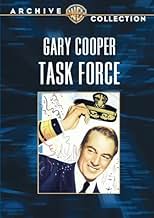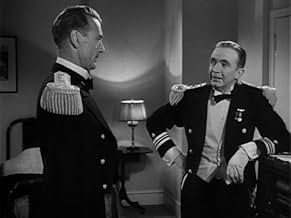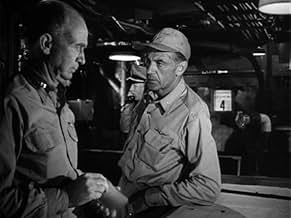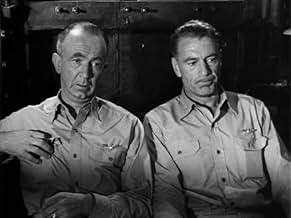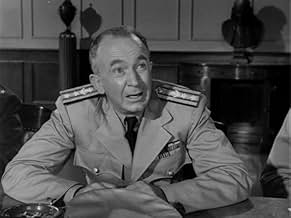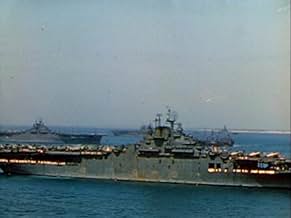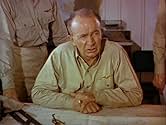PUNTUACIÓN EN IMDb
6,6/10
1,3 mil
TU PUNTUACIÓN
A punto de jubilarse, Jonathan Scott recuerda su larga carrera en la marina y la evolución del papel del portaaviones desde principios de los años 20.A punto de jubilarse, Jonathan Scott recuerda su larga carrera en la marina y la evolución del papel del portaaviones desde principios de los años 20.A punto de jubilarse, Jonathan Scott recuerda su larga carrera en la marina y la evolución del papel del portaaviones desde principios de los años 20.
- Dirección
- Guión
- Reparto principal
- Premios
- 3 premios en total
Joel Allen
- Pilot
- (sin acreditar)
Roger Anderson
- Pilot
- (sin acreditar)
Gregg Barton
- Pilot
- (sin acreditar)
Roscoe J. Behan
- Ames' Attache
- (sin acreditar)
Reseñas destacadas
I thought I saw all of Gary Cooper's war movies, but I just caught this one today on TMC. As others have stated, Brennan and Cooper are a great pair and they were a very good pair in this movie. Except for the typical lack of bloody wounds (in forties war movies), it was impressive that the dramatic detail in this movie was more accurate than usual for this genre. The movie did a great job depicting the interaction in the CIC (combat information center) and elsewhere on the ships. However unusual it seemed, transitioning from black and white to color to show plot transition (The Wizard of Oz notwithstanding) was effective for me. Deep down, I think it might have been a way to sneak in color war footage. As I am also a Jane Wyatt (Spock's mother) fan, she was great as Scott's (Gary Cooper's character) wife. Although it did seem to be a bit incongruous that she dressed as well as she did considering her situation. (Sorry, you'll have to see the movie.) Summary: Whether or not you've seen Midway, see Task Force.
Gary Cooper plays a navy man that was one of the first pilots trained to fly from an aircraft carrier (the USS Langley) and continues his career through WWII until his retirement. The first section of the film focuses a lot on Cooper and his relationships with friends, his future wife and the navy brass.
Later, when WWII arrives, the film is much more of an action flick and gives a very competent overview of the war in the Pacific. While this did employ a lot of stock footage, it was unusual in that most all of the footage was used correctly. Unlike the ridiculously historically inaccurate film, MIDWAY (1976), TASK FORCE made sure to use clips that were accurate--featuring the correct model planes for each segment of the war (whereas in MIDWAY, they often showed planes that weren't even in the naval arsenal until well after the battle as well as had dive bombers magically turn into fighter planes in mid-flight due to horrid editing blunders).
This film really has widely different appeal depending on your perspective. If you are a history teacher and airplane nut like me, then it earns a 9 because it does a really good job of conveying the history of the American aircraft carriers from its inception in the early 1920s through WWII. However, if you are not, then you might find the film a bit cold (as it often focuses more on events than people towards the middle to the end of the film) and it might seem a bit confusing if you aren't familiar with the history of these great ships.
Later, when WWII arrives, the film is much more of an action flick and gives a very competent overview of the war in the Pacific. While this did employ a lot of stock footage, it was unusual in that most all of the footage was used correctly. Unlike the ridiculously historically inaccurate film, MIDWAY (1976), TASK FORCE made sure to use clips that were accurate--featuring the correct model planes for each segment of the war (whereas in MIDWAY, they often showed planes that weren't even in the naval arsenal until well after the battle as well as had dive bombers magically turn into fighter planes in mid-flight due to horrid editing blunders).
This film really has widely different appeal depending on your perspective. If you are a history teacher and airplane nut like me, then it earns a 9 because it does a really good job of conveying the history of the American aircraft carriers from its inception in the early 1920s through WWII. However, if you are not, then you might find the film a bit cold (as it often focuses more on events than people towards the middle to the end of the film) and it might seem a bit confusing if you aren't familiar with the history of these great ships.
This past week I watched "Task Force" on Turner Classic Movies. What a great movie about US Naval Aviation, before and during WWII. For starters, the actors play their parts masterfully. You can tell that Gary Cooper really enjoys playing this character and telling this Navy story. I also liked how the movie had continuity of time, being that the story spanned many years. Perhaps most of all, I enjoyed the footage of the aircraft carriers themselves. I thought to myself, how the carriers that they were filming on, only a few years before 1949, were the centerpiece of the most horrific combat of WWII. I am sure many of the actors and those who saw the film remembered vividly when the news from the Battle of Midway and Okinawa reached home. So many young Americans died. What brought a tear to my eye, was the video at the end of the movie when the USS Enterprise is returning to NY City. The camera man at the time in 1945, films the damage with NYC icons like the Statue of Liberty and Brooklyn Bridge in the background. It is amazing footage. I thought to myself how the young veterans in the audience in 1949 must have reflected on their war fought only a few years before. Therefore, I love how this movie of history is indeed history itself.
This has a structure much like the FBI Story where the story of the FBI itself as seen through the eyes of one man is weaved with the personal story of that one man. Here the story of naval aviation is weaved with the story of one mythical witness to that history. In this case the fictional man is Jonathan Scott (Gary Cooper). Scott is getting ready to retire in present day (1949) and then thinks back on all that has transpired in the last 27 years when he and several other pilots were to learn how to land and take off aboard an air craft carrier.
For all the history he witnessed, Scott had a rather tragic life. He wanted to be a pilot. But he gets sent to Washington, then to a desk job in Panama, then to Annapolis as an instructor, and then he is promoted to being an officer on a carrier in the Pacific when WWII begins. Seldom is he in the air himself. That's not the way the film sold it, but I did notice that aspect. Then there is Scott's personal life. He falls in love with Mary Morgan (Jane Wyatt), the widow of a pilot friend of his who died in a plane crash. The two develop feelings for each other fairly quickly, but don't do anything about them for over seven years. Mary says she does not want to marry a pilot again and always worry, and ironically the way Scott's life worked out she wouldn't have been marrying one even if she married Scott early on! And then after Scott actually DOES crash his plane THEN she decides to accept his proposal! Jane Wyatt seems a little homespun for the likes of Coop, but the two actors make it work.
There's lots of actual footage of WWII aerial battles, and you can tell real care went into detail so that this film looked authentic. For some reason, the film switches over to color about two thirds into it. That is where most of the action takes place, but it is rather an odd switchover, seeming somewhat like a holdover from the 1930s when individual scenes of a black and white movie would be shot in color.
Warner Brothers put their best supporting players into this film including Wayne Morris and Bruce Bennett, and there is Walter Brennan making his eighth and final appearance in a film with Gary Cooper. There's also a very early appearance by Julie London as the wife of one of the pilots. If you are interested in naval history this is an interesting way to spend a couple of hours.
For all the history he witnessed, Scott had a rather tragic life. He wanted to be a pilot. But he gets sent to Washington, then to a desk job in Panama, then to Annapolis as an instructor, and then he is promoted to being an officer on a carrier in the Pacific when WWII begins. Seldom is he in the air himself. That's not the way the film sold it, but I did notice that aspect. Then there is Scott's personal life. He falls in love with Mary Morgan (Jane Wyatt), the widow of a pilot friend of his who died in a plane crash. The two develop feelings for each other fairly quickly, but don't do anything about them for over seven years. Mary says she does not want to marry a pilot again and always worry, and ironically the way Scott's life worked out she wouldn't have been marrying one even if she married Scott early on! And then after Scott actually DOES crash his plane THEN she decides to accept his proposal! Jane Wyatt seems a little homespun for the likes of Coop, but the two actors make it work.
There's lots of actual footage of WWII aerial battles, and you can tell real care went into detail so that this film looked authentic. For some reason, the film switches over to color about two thirds into it. That is where most of the action takes place, but it is rather an odd switchover, seeming somewhat like a holdover from the 1930s when individual scenes of a black and white movie would be shot in color.
Warner Brothers put their best supporting players into this film including Wayne Morris and Bruce Bennett, and there is Walter Brennan making his eighth and final appearance in a film with Gary Cooper. There's also a very early appearance by Julie London as the wife of one of the pilots. If you are interested in naval history this is an interesting way to spend a couple of hours.
Gary Cooper and Jane Wyatt shine in this 1949 film about the history of aviation in warfare.
The picture begins in 1922 when carriers were just getting started. The picture is at its best when we see the early American isolationism that evolved after World War 1.
Gary Cooper is in fine form as the pilot who is banished to Panama for stepping on too many toes for his pro-carrier beliefs. Jane Wyatt plays a woman who loses her husband during a practice run and marries Cooper later on.
The last 20 minutes of the film is shown in Technicolor under the admirable direction of Natalie Kalmus, a person used Technicolor so vibrantly in the films of the late 1930s and 1940s as well. The battle scenes are quite authentic and this picture serves well as a tribute to our fighting forces during World War 11.
The picture begins in 1922 when carriers were just getting started. The picture is at its best when we see the early American isolationism that evolved after World War 1.
Gary Cooper is in fine form as the pilot who is banished to Panama for stepping on too many toes for his pro-carrier beliefs. Jane Wyatt plays a woman who loses her husband during a practice run and marries Cooper later on.
The last 20 minutes of the film is shown in Technicolor under the admirable direction of Natalie Kalmus, a person used Technicolor so vibrantly in the films of the late 1930s and 1940s as well. The battle scenes are quite authentic and this picture serves well as a tribute to our fighting forces during World War 11.
¿Sabías que...?
- CuriosidadesWayne Morris who portrayed Lt.McKinney was the only actor in the cast who had actual combat experience as a carrier pilot in WWII. As a fighter pilot, Morris shot down seven enemy planes and contributed to the sinking of five enemy ships. He was awarded four Distinguished Flying Crosses and two Air Medals. He was the only combat "ace" of all the Hollywood actors who went to war.
- PifiasDuring the attack sequence on the Japanese carriers at Midway, the film shows the dive bombers striking first. Actually, it was the torpedo bombers that attacked first. This was caused by missed communications between the torpedo planes and the fighter cover. It was supposed to be a coordinated high-low attack. Almost every torpedo plane was shot down. No torpedoes made hits. While a tragic accident, the torpedo planes drew the Japanese fighter cover down to wave top height. When the U.S. fighters and dive bombers arrived there were very few Japanese fighters to intercept them.
- Citas
Pete Richard: The disarmament conference is over. They've sunk the fleet. The Missouri, the South Dakota, the Maine, the Virginia, Nebraska Georgia. 30 capital ships. More ships sunk with the stroke of a pen than have been sunk in our entire history.
- ConexionesEdited from December 7th (1943)
- Banda sonoraTea for Two
(uncredited)
Music by Vincent Youmans
Played when Cmdr. Richard introduces Lt. Scott to the Admiral and his wife
Selecciones populares
Inicia sesión para calificar y añadir a tu lista para recibir recomendaciones personalizadas
- How long is Task Force?Con tecnología de Alexa
Detalles
- Duración
- 1h 56min(116 min)
- Color
- Relación de aspecto
- 1.37 : 1
Contribuir a esta página
Sugerir un cambio o añadir el contenido que falta


